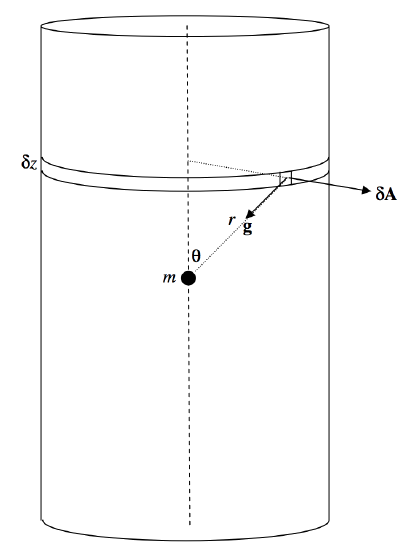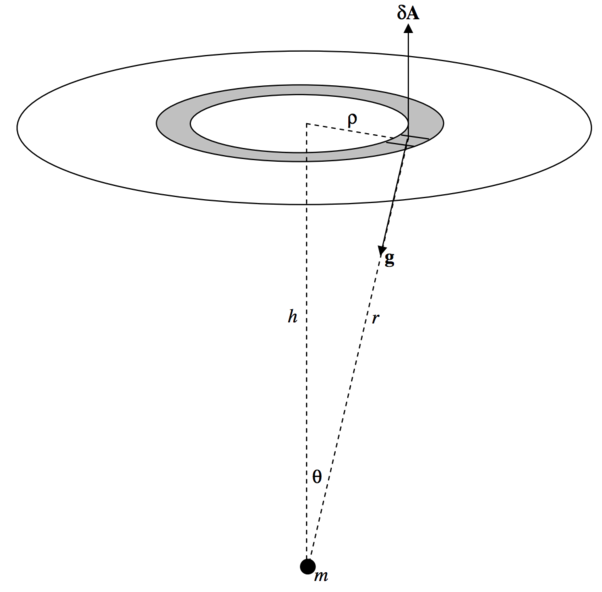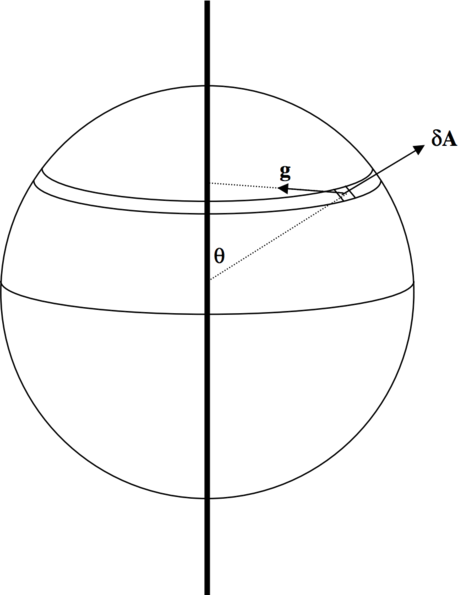5.6: Calculating Surface Integrals
( \newcommand{\kernel}{\mathrm{null}\,}\)
While the concept of a surface integral sounds easy enough, how do we actually calculate one in practice? In this section I do two examples.
In Figure V.19 I show a small mass m, and I have surrounded it with a cylinder of radius a and height 2h. The problem is to calculate the surface integral ∫g⋅dA through the entire surface of the cylinder. Of course we already know, from Gauss’s theorem, that the answer is =−4πGm, but we would like to see a surface integral actually carried out.

FIGURE V.19
I have drawn a small element of the surface. Its area δA is dz times aδϕ, where ϕ is the usual azimuthal angle of cylindrical coordinates. That is, δA=a δz δϕ. The magnitude g of the field there is Gm/r2, and the angle between g and dA is 90∘+θ. The outward flux through the small element is
g⋅δA=Gmacos(θ+90∘)δzδϕr2.
(This is negative – i.e. it is actually an inward flux – because cos(θ+90∘)=−sinθ.) When integrated around the elemental strip δz, this is −2πGmasinθδzr2. To find the flux over the total curved surface, let’s integrate this from z=0 to h and double it, or, easier, from θ=π/2 to α and double it, where tanα=a/h. We’ll need to express z and r in terms of θ (that’s easy:- z=acotθ and r=acscθ),and the integral becomes
4πGm∫απ/2sinθ dθ=−4πGmcosα
Let us now find the flux through one of the flat ends of the cylinder.

FIGURE V.20
This time, δA=ρ δρ δϕ, g=Gm/r2 and the angle between g and δA is 180∘−θ. The outwards flux through the small element is Gmρcos(180∘−θ)δρδϕr2 and when integrated around the annulus this becomes −2πGmcosθ ρδρr2. We now have to integrate this from ρ=0 to a, or, better, from θ=0 to α. We have r=hsecθ and ρ=htanθ, and the integral becomes
−2πGm∫α0sinθdθ=−2πGm(1−cosα).
There are two ends, so the total flux through the entire cylinder is twice this plus Equation 5.6.1 to give
ϕ=−4πGm,
as expected from Gauss’s theorem.
In figure V.21 I have drawn (part of) an infinite rod whose mass per unit length is λ. I have drawn around it a sphere of radius a. The problem will be to determine the total normal flux through the sphere. From Gauss’s theorem, we know that the answer must be −8πGαλ.

FIGURE V.21
The vector δA representing the element of area is directed away from the centre of the sphere, and the vector g is directed towards the nearest point of the rod. The angle between them is θ+90∘. The magnitude of δA in spherical coordinates is a2sinθδθδϕ, and the magnitude of g is (see Equation 5.4.15) 2Gλasinθ. The dot product g⋅δA is
2Gλasinθ⋅a2sinθδθδϕ⋅cos(θ+90∘)=−2Gλasinθδθδϕ.
To find the total flux, this must be integrated from ϕ=0 to 2π and from θ=0 to π. The result, as expected, is −8πGαλ.


